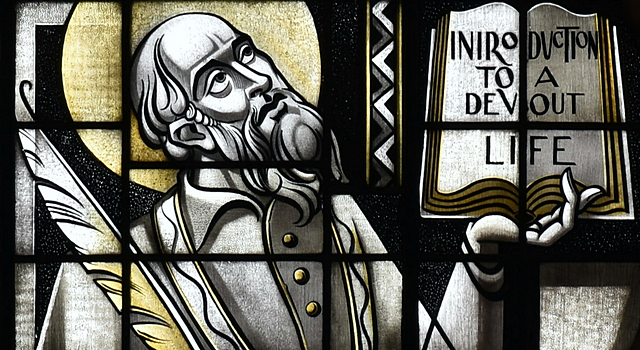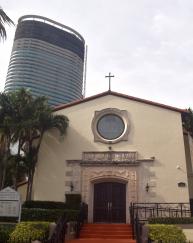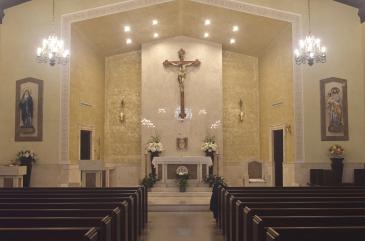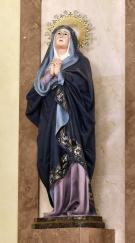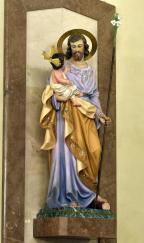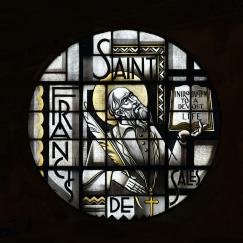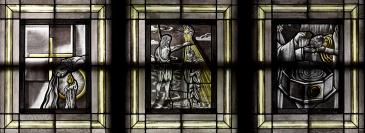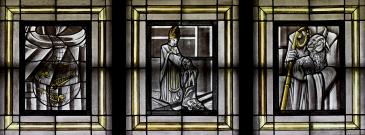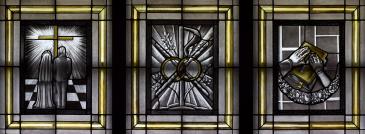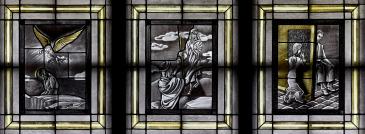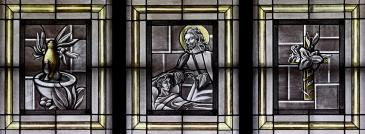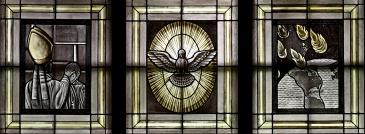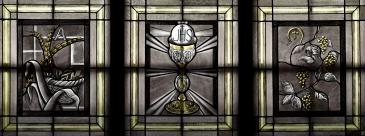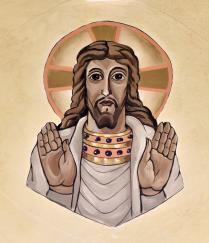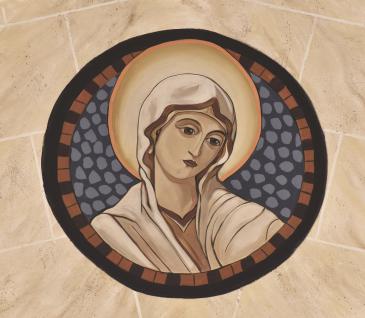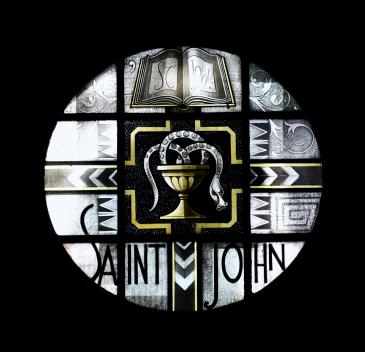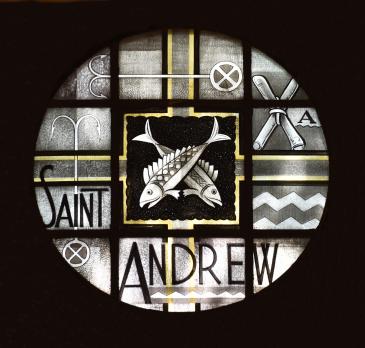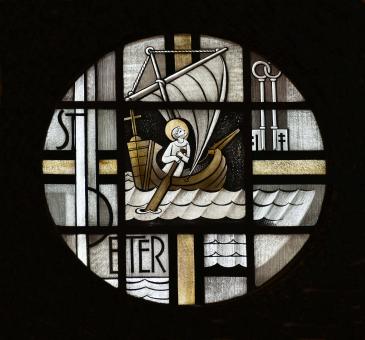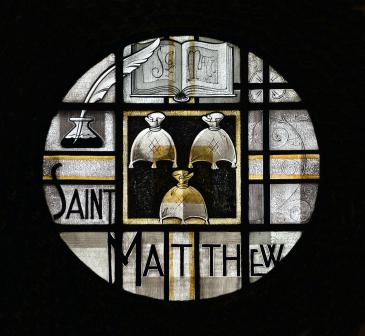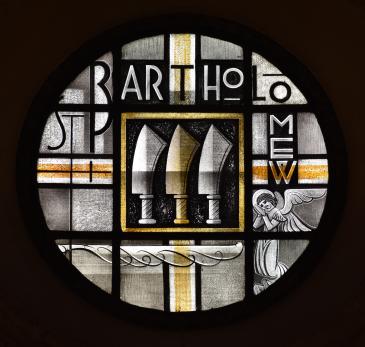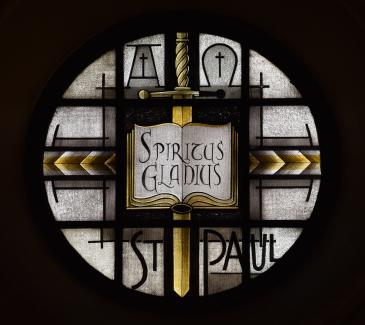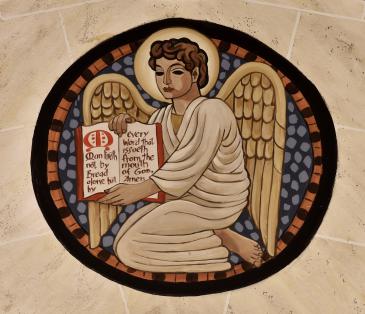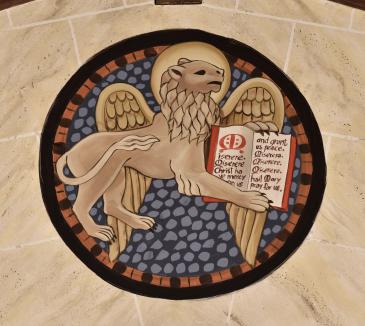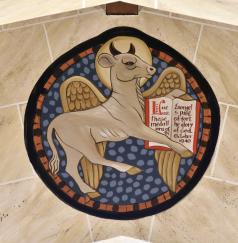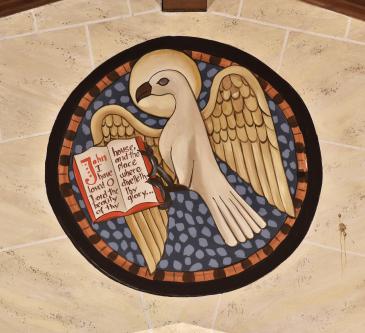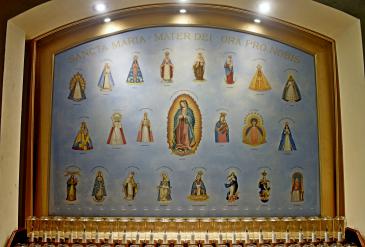By Jim Davis - Florida Catholic
Photography: Jim Davis
MIAMI BEACH | Once and it’s an accident. Twice and it’s a coincidence. But three times? God just may be telling you something.
That’s how the future St. Francis de Sales took it when his sword and scabbard fell in the shape of a cross. The event impelled him to trade his sword for a pen and priesthood, earning him the title of patron saint of journalists.
It’s not what his high-class family wanted. Born in 1567 in Savoy, near Geneva – in the family castle – Francis was devout and prayerful as a youth, but studied law to please his father. He attended the University of Padua, earning a doctorate in law at the age of 24.
One day, he fell off his horse, and his sword somehow fell out of its scabbard. To his astonishment, the two items landed in the shape of a cross. Then it happened twice more that day.
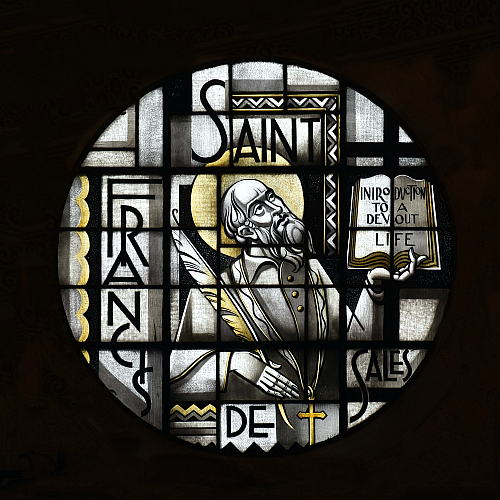
Photographer: Jim Davis | FC
Rose window at St. Francis de Sales Church, Miami Beach, shows the saint with the title of his best-known work.
That was enough for him to act on a longstanding pull toward the priesthood, despite his father’s displeasure. He was ordained and, in 1593, elected provost of the Diocese of Geneva.
It was not a peaceful time for religion in Europe. The Reformation was in full force, marred with wars of words and even weapons over how to worship God and gain salvation.
Francis focused on the Chablais region, a stronghold of Calvinist Protestants. For four years, he endured rocks, insults, slammed doors, even death threats.
In the face of such treatment, he developed his signature method of writing simple leaflets on Catholic belief, then slipping them under doors. It was one of the first-ever uses of religious tracts.
Francis’ other major instrument was his own personality: warm, charming, citing scripture and doctrine, but with grace and respect. He has often been called the Gentleman Saint.
“Nothing is so strong as gentleness,” he famously said. “Nothing is so gentle as real strength.”
By the time he wrapped up his three-year campaign, he had won an estimated 40,000 people back to the Catholic Church.
Francis became bishop of Geneva in 1602, turning his teaching and writing skills to clergy reform. Two years later, he met Jane Frances de Chantal, a devout widow, and became her spiritual guide. The relationship developed in 1618 into a new order, the Visitation of Holy Mary.
Not only for personal appeal and writing talent is St. Francis remembered. It’s also for his teaching that everyone can and should attain holiness.
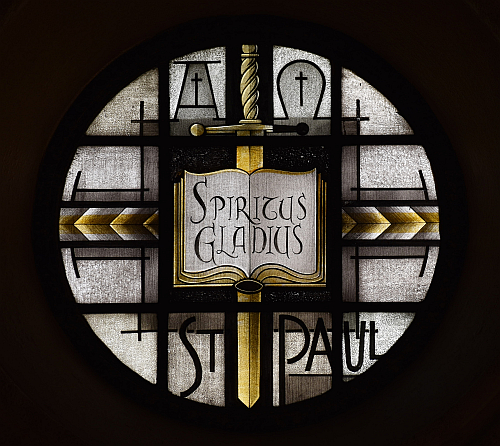
Photographer: Jim Davis | FC
St. Paul is honored in this circular window at St. Francis de Sales Church, Miami Beach. In this window, a Bible lies atop a sword, with the Latin phrase "Spiritus Gladius," or "Sword of the Spirit." The phrase appears in Ephesians 6:17, which Paul wrote.
At the time, most people believed that one had to become a priest or monk or nun to become holy. But Francis taught that anyone – a baker or soldier or craftsman – could also be devoted to God.
“Let us be what we are and be that well,” he wrote, “in order to bring honor to the Master Craftsman whose handiwork we are.”
Francis honed his writing skills not only in tracts but in letters and books. His best-known work is “Introduction to the Devout Life.”
He wrote not only on subjects like the sacraments but more every day matters like character and friendship. He taught that love for God would flow to love and service for others.
“The measure of love is to love without measure,” he wrote.
Francis kept a kind spirit throughout his life. He denounced judgmentalism as a terrible sin.
“We accuse our neighbor for little, and we excuse ourselves in much,” he observed dryly. “The business of finding fault is very easy, and that of doing better very difficult.”
These teachings may seem obvious in the light of modern doctrine, but they foreshadowed, by centuries, the “universal call to holiness” of Vatican II.
Francis drove himself relentlessly, teaching, preaching and writing. He died of a cerebral hemorrhage in 1622 and was canonized in 1665.
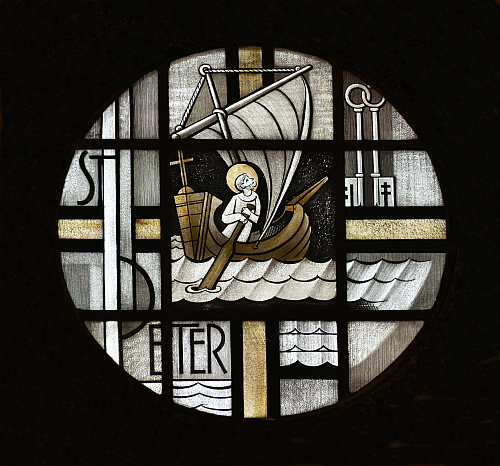
Photographer: Jim Davis | FC
St. Peter is honored in this circular window at St. Francis de Sales Church, Miami Beach. He steers a boat for his pre-apostolic fishing trade. But he looks to the Keys of the Kingdom given him by Jesus.
Two centuries later, Francis was named a Doctor of the Church, someone of exemplary holiness and spiritual wisdom. He is the patron saint not only of journalists but of adult education and the deaf. His feast day is Jan. 24.
Last year, Pope Francis reflected on the 400th anniversary of the saint’s death. “His flexibility and his far-sighted vision have much to say to us,” the Holy Father said in an apostolic letter.
“Today he bids us set aside undue concern for ourselves, for our structures and for what society thinks about us, and consider instead the real spiritual needs and expectations of our people.”
On Miami Beach, St. Francis de Sales Church was founded in 1964, even before Miami was named an archdiocese in 1968. But its prehistory goes farther back – with Msgr. William Barry, founder of St. Patrick Church, a few miles southward.
Msgr. Barry saw the need for another church on the Beach, and he built St. Francis de Sales Mission Chapel in 1940. Priests from St. Patrick’s served there on weekends with confessions and Mass.
When the chapel became a full-fledged parish, its first pastor was Father Francis Dunleavy, longtime assistant to the monsignor. A recruit from Ireland, Father Dunleavy served in South Florida for nearly 65 years, one of the longest priestly tenures in Florida’s history.
The church, with its Mediterranean-style cream-colored walls and terracotta roof, contrasts sharply with the multi-story condos of South Beach. But its mission remains to serve the spiritual needs of residents and visitors alike.
It’s even in a slogan of the parish: “When you come to the beach, don’t forget who made it.”
